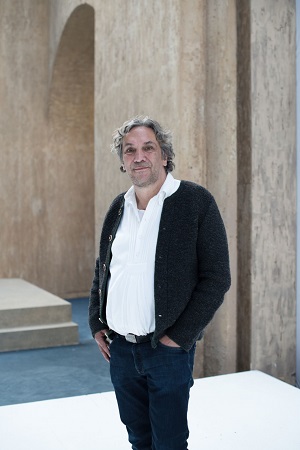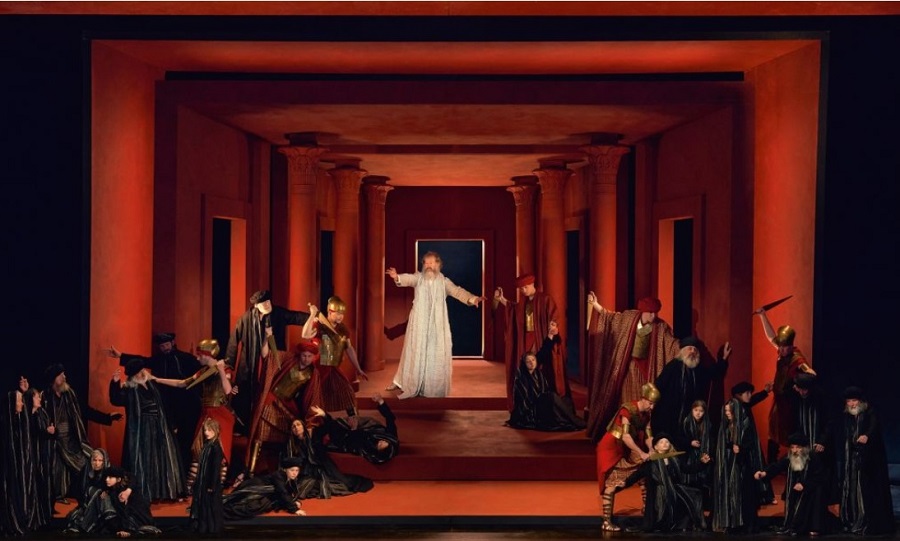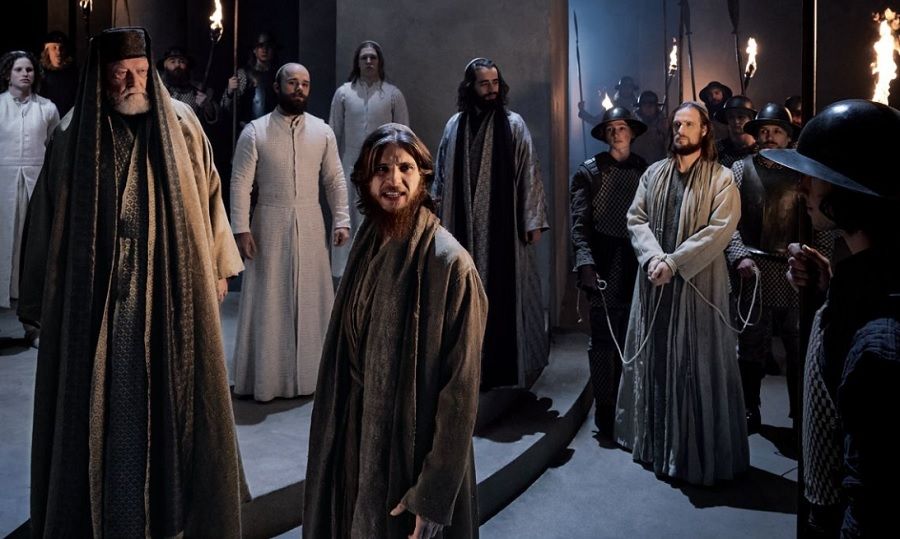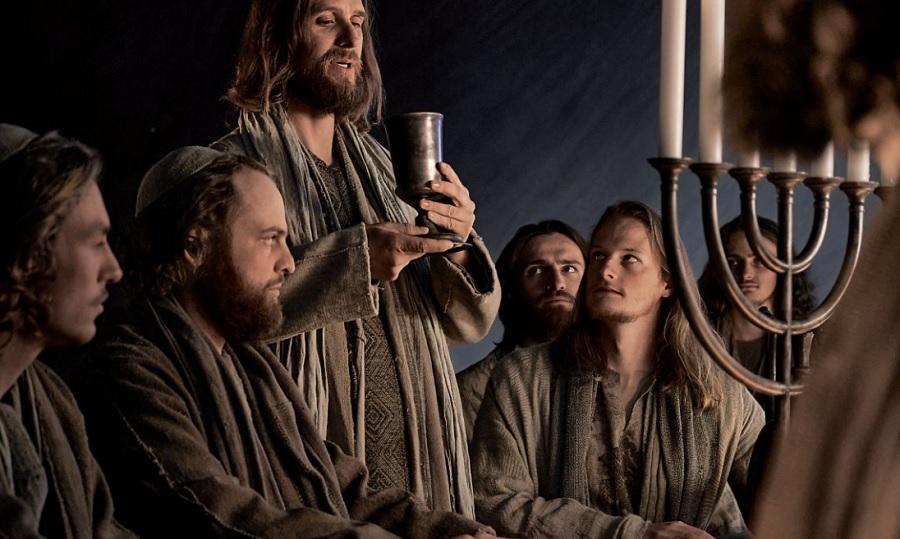Imagine 42 different revivals of the same six-hour (!) Christmas play at an open-air Radio City Music Hall. Now stipulate that each of these revivals is spaced roughly a decade apart from the next, with an uncopyrighted script under constant debate by religious scholars worldwide, mostly due to the play’s penchant for anti-Semitism. Any significant script changes must be voted on by the entire New York City Council, and everyone in the play has to have been born in Manhattan, or at least been a resident thereof for 20 years. Final proviso: More recent productions have required around 2,000 people to people the cast and crew, with all 20 main roles, the 64-person chorus, and the 57-person orchestra being double-cast.
Now you have a rough analogue for the Passion Play at Oberammergau, Germany, the tiny Alpine village in Germany that has served as a Theatrum Mundi for nearly 400 years. It has been almost that long since the villagers made a famous vow in 1633 to present Christ’s Passion every 10 years if God would only spare them further deaths from the Black Plague. There have been a few adjustments due to wars (WWI and II), Spanish flu, and now—no surprise—due to our new plague of COVID-19. Scheduled for 2020, the revival that finally opened May 14, and runs there until early October, had been postponed two years, necessitating dozens of re-castings and even more costume alterations (pandemic pounds?).
The wait, however, was worth it. Thanks to steady work since 1990 to maximize the play’s ecumenicism via ever bolder changes in characterizations and design (especially of the reworked Old Testament tableaux vivants so integral to the production), the 2022 edition warrants a higher term of approbation than “revival.” I’d go so far as to call it a “resurrection,” with good old-fashioned theatricality ascendant. There’s still a community theatre feel that’s a suitably far cry from the Rockettes. But when a minor character tells Jesus (Frederik Mayet at the performance I saw), “Jesus, the city is full of refugees who have left their villages for fear of the Romans,” the audience knows they can mentally substitute “Ukrainians” for refugees and “Russians” for Romans. Putin as Pilate? Yes, the play is all too pertinent and alive in that sense.

When I was fortunate enough to review the Oberammergau Passion Play for American Theatre in 1990, I wrote (with the brio of youth), “A good dramaturg could easily excise many redundancies from the sometimes ponderous 1990 script.” A good dramaturg, Otto Huber, had indeed already tried, only to be turned down by the Oberammergau town council. But 1990 was also the fateful year then-29-year-old Christian Stückl took over as Passion play director, beginning a 30-year directorial crusade to lessen the play’s endemic anti-Semitism, grant equal opportunities to women, and make the play both hermeneutically and dramatically relevant and sound. In 2000, the second time I reviewed the play, I was aware of some improvements in the six-hour script and wowed by an exhibition of Robert Wilson’s radical 14 Stations of the Cross, displayed right outside the theatre at Stückl’s invitation.
The 2010 edition (which I missed) ushered in even bigger changes, nicely reported in a collection of essays edited by Kevin J. Wetmore Jr. Huber and Stückl’s more substantial cuts had evidently been allowed, bringing the length of the play down from six hours to about five and a half. Also innovative was Stückl’s team’s decision to start the play at 2:30 p.m. in the afternoon instead of at the customary 9 or 10 a.m. This meant, with an intermission for dinner instead of lunch, playgoers saw the crucifixion and its attendant signs and wonders in natural darkness rather than light.
The healing spirit of the whole 2022 endeavor was enhanced by a pre-premiere morning ecumenical service in the vast 4,400-seat theatre, with separate adult and children’s choruses and a small orchestra. As with previous pre-play moments, some child participants managed to be scene stealers: This time instead of a little girl sneaking onstage to wave a palm at her parents (pre-show 2000), we had a priceless small boy singer in a dark suit who twice ended choruses with an overly enthusiastic “Hallelu-JAH!” Spiritual statements were then delivered by a rare tag team of liberal clerics led by Reinhard Marx, who serves as both the Catholic Archbishop of Munich and the Cardinal of Freising, and the former head of the German Protestants, Regional Bishop Heinrich Bedford-Strohm. A common theme of their side-by-side sermons was the strength of the right (meaning the good, not the political orientation) over the right of strength, with Jesus as exemplum. After the religious remarks came a full-fledged community ceremony during which Stückl, now about 60, received a standing O on introduction, partly to recognize his Abraham-Geiger award, presented by a German rabbinical university, for his having led the modern charge to cleanse the play of the nasty features Hitler so enjoyed on his visit in 1934. Speaking in a Bavarian dialect impenetrable to me as a lifelong struggler with High German, but appropriate for the community occasion, Stückl handed out framed certificates to cast members, 46 of whom had appeared in 8 revivals of the Passion play, 39 of whom had appeared in 9, and 12 who had participated in 12 productions. Community reps (stage left) and religious reps (stage right) were visually bonded as one.
On the play’s official website, Stückl is frank about his hard-won struggle to modify the play. Oberammergau does, it turns out, have its share of objectors to “Überfremdung” (the same notion as the racist “replacement theory”), and Stückl can claim some degree of influence. “Each presentation changes enormously,” he writes. “Since the Passion play takes place every 10 years, I must always rewrite the text and tell the story anew. I am flooded with realizations that I gained at the previous show and it must also reflect the current times and political conditions.”
Working with his own multi-seasoned team—Huber as dramaturg, Stefan Hageneier as stage and costume designer, Markus Zwink as music director, plus theological advisor Prof. Dr. Ludwig Mödl, from Holy Spirit Church in Munich (part of the important Munich church-and-theatre “Mafia” engaged with the play)—Stückl reconceived the role of Judas (played at the premiere by Cengiz Görür, a Muslim Oberammergauer acting student) as “the betrayed traitor.” Instead Pilate (Anton Preisinger, a hotelier in real life) becomes the true heavy; several Hebrew passages and/or songs have been added; and the Last Supper (as in 2010) is patently also a Last Seder, including a period-correct seven-armed Menorah and the familiar question, “What makes this night different from all other nights?,” uttered here by the apostle John (Anton Preisinger Jr., son of the actor playing Pilate). Stückl has likewise lengthened the debates among Jewish religious officials and some of Jesus’s most articulate followers, especially Nicodemus (Abdullah Karaca, also the show’s “second director”) and Joseph of Arimathea (Walter Rutz), about what the Galilean’s presence in Jerusalem might mean for their future under Roman occupation. There have even been renovations to the massive stage for 2022, creating a multipurpose but unified “temple of Jerusalem” set, with the all-important inner stage still used for the dozen freshly conceived Old Testament tableaux that punctuate (albeit indirectly) the New Testament passion action.

It is impossible to overstate the importance of the musical oratorio, composed by Rochus Dedler (1779-1822), and the choral commentary that begins the play (followed by a short updated prologue) and which accompanies each of the dozen Old Testament tableaux (cut back from 25 at one point). Markus Zwink has expanded and updated Dedler’s early Romantic score so that gifted community soloists now dialogue with the chorus in song to stimulate the audience’s curiosity about just how Adam and Eve, Abraham and Isaac, Joseph and Pharaoh, Noah and family, Daniel and the lions, plus Moses and everybody (several tableaux feature Moses) relate to Jesus’s story. The convention at work is, of course, prefiguration—the idea that Old Testament passages foretell Jesus’s advent and life. Many critics have noted that the notion that one religion exists merely for the purpose of foretelling another is unpalatable for those in the supposedly superseded religion. That’s probably why Stückl seems to suggest, with choices in staging and design (including the wildly colorful, almost surrealistic 2022 tableaux), that one might just as soon see things the other way around—i.e., Jesus as a post-figuration for Moses, Joseph, etc. It is really the power of theatricality itself that contemporizes and valorizes everything onstage. Stückl lands a welcome blow against anti-Semitism, while also landing one in favor of the notion that Jesus, among other great proponents of nonviolence (e.g., Gandhi, Martin Luther King Jr.), is there to benefit all humanity.
Frederik Mayet’s Jesus is, not surprisingly, at the deep core of the play. It’s at first a bit shocking to learn that his day job is leader of public relations for the Passion play; but soon it becomes somehow fitting. Mayet also works with Stückl at the Münchner Volkstheater. Oberammergau-born, they are both theatre professionals, and it shows in Mayet’s performance. From silently caressing a child or beggar in the street to inveighing against the hypocrisy of Caiaphas (Andreas Richter) and company, Jesus carries the day. The danger is that his lines are all too familiar, sometimes giving us the impression of a Greatest Hits of the New Testament performance. The Beatitudes are there, sometimes divided up and given to an apostle to mention. The Lord’s Prayer is likewise apportioned to individual disciples at the Last Supper/Last Seder, showing they have clearly already absorbed their master’s teachings.
One big challenge of the lead role is that Jesus must stand still, often in silence, while the debates about his radical agenda rage on around him. Eventually bound and bloodied, and eventually carrying his enormous wooden cross—the chief focus, after all, of the whole production—Mayet as Jesus moves slowly and painfully toward his appointed end. The crucifixion, even on a third viewing of the play, cannot help but leave a spectator aghast. The stagecraft is simple but wrenchingly effective. It is hard to conceive of the actors actually rehearsing the steps: nailing a man’s flesh to wood, then hoisting him aloft with searing pain and no visible means of bodily support. The deposition (removal) of Jesus’ body from the cross, after his traditional cries to God on his own and then humankind’s behalf, is an equally harrowing sight. There are no special effects at Oberammergau, no rear stage projections to cheat out missing scenery.
The only moment somewhat comparable in effect to the crucifixion is Judas’ onstage suicide by hanging, made all the more affecting in this 2022 production by the overall rehabilitation of Judas as a tragic character. No longer the villain (as mentioned, Pilate, the colonial oppressor, now fills that role), Judas has clearly begun his relationship with Jesus as a close friend and confidant. Their political beliefs—radical change for humankind and an end to hypocrisy and deceit—have never really diverged. Judas is simply too eager for action, expecting an open revolt against the Romans and their Jewish allies. He hasn’t grasped that Jesus will never make war, nonviolence being a chief tenet of his beliefs. When Judas leads the soldiers to arrest Jesus in Gethsemane, he traditionally betrays his master with a kiss. But in this production, it is Jesus who kisses the arriving Judas, also calling him “friend.” Soon after Jesus’s betrayal by Judas in the Garden of Gethsemane comes Peter’s (Benedikt Geisenhof) analogous thrice-iterated denial that he even knows Jesus. (Real cocks crowing from the farms abutting the theatre had been heard pre-play.) The difference in the cases is merely that Peter seeks forgiveness and Judas does not. Judas despairs, affixes his noose, which he calls a “serpent,” and swings before our eyes onstage, using a low-tech but again fully convincing stage effect.

While Judas has been moved toward the good on a sliding scale of dastardliness, Pilate, clad in a long black leather coat and gloves (shades of a WWII-era SS officer), has been pushed toward the bad. Only his chest plate of armor designates Pilate as particularly Roman. He arrives onstage riding a real, very large black horse, a working breed of the kind a medieval knight might have ridden. (The only protesters I saw at this year’s production were three young people holding up placards against the stage use of live animals.) Herod (Benedikt Fischer) arrives on a similar black horse to torment Jesus in a combined scene. Fischer hams it up, following a Passion play tradition Chaucer even mentioned in The Canterbury Tales, by trying to get Jesus to do some miracle for him. Herod comes across like some Vegas talent scout looking for his next headliner. Jesus unsurprisingly demurs.
Pilate’s wife, her pro-Jesus role enhanced to give more visibility to women, enters wearing a black dress, with tailoring so simple but smart it might also work (perhaps sleeveless) in Vegas. Black, with white sometimes added, is also a thematic color for the chorus, who were clad all in white for 2010. The new outfits look almost Amish in plainness, but they fit the production’s sense of “pastoral dignity,” Joshua Edelmann’s still-apt term in Wetmore’s collection on the 2010 production. The Jewish citizens of Jerusalem are clad in earth tones, with Caiaphas and his ranking supporters wearing brocade and costly garments in similar earth colors but with more elaborate headdresses (fortunately missing the horns that marked the high priests as devils in many long-past productions). Caiaphas and Pilate have a tete à tete in which Caiaphas kisses up to his Roman overlord rather alarmingly. Caiaphas seems particularly put out at Jesus for the Galilean’s sheer arrogance (“Who are you to forgive sins?”), which Caiaphas feels endangers not only his power but Jerusalem at large. Representing more broad-minded, educated Jews, however, we have Nicodemus and Joseph of Arimathea, both of whom vigorously defend Jesus.
The lead women in the cast, Mary Magdalene (Barbara Schuster, alternating with her own sister Sophie in the role) and Jesus’s mother Mary (Andrea Hecht, a salesclerk and wood sculptor in real life), assume increasing importance as the play nears its end. From her early-in-the-play warning to Jesus that he’s become obsessed with his heavenly father’s work and should come back home to Nazareth, Jesus’s mother moves towards acceptance of her son’s gruesome chosen fate. On being informed of Jesus’s resurrection from the tomb, reported by a white-clad wingless angel (the tableau angels do have wings), Mary Magdalene is first to believe and to declare, in the words of a well-loved hymn, “I know that my redeemer lives.” Both Marys set off to inform and convince Jesus’s shaken male followers. We see nothing else of Jesus’s resurrection, only the characters’ final exit with a small symbolic fire left burning onstage. There’s no curtain call at this play’s end. There is a real black sky, and the same chill wind blows down from the nearby mountain on the just and the unjust.
Fire, snakes, flood, and especially blood are thematic elements to the end, both in the Passion portions and especially in the completely motionless tableaux that are placed in the story of Jesus’s last three days at seemingly random moments, with the audience task to draw analogies (though some interpretive help is given, chiefly by the choral interlude paired with each tableau). Red, yellow, gold, and blue predominate there, with designer Hageneier pulling out all the stops for Moses parting a very Red Sea, crafted from some brilliant red solid substance, a bit like Play-Doh waves, baked with a shiny glaze. The same red substance is used to similar surreal effect in a tableau about the Israelites encountering snakes in their 40 years in the desert. A gigantic shiny red serpent twists around a central stake, while smaller red ones attack their hapless victims. The chorus sings, “From the poisonous bite of the serpent came liberation to the people.” The connection with Jesus’s suffering is oblique, but it’s there. Similar riddles for the audience to solve occur in all the tableaux, always revealed on the curtained inner stage, with characters frozen in active poses. As the curtain closes on each tableau, one cannot help but look for someone to move early. But over the course of five and a half hours, I saw no tableau actor even flinch, evidence of an acting company serious in its intent.
It is finally the whole community’s intent, albeit shaped by one director and his team, by which one must judge the work at Oberammergau. Thanks to Stückl’s work with Jewish leaders, the most egregious examples of anti-Semitism and sexism are in the past, though there remain some tensions among the Oberammergauers and organizations such as the Anti-Defamation League and the American Jewish Committee. In a May 9, on the AJC website, Rabbi Noam E. Marans noted, “The play has been transformed, not perfected, and the work against anti-Jewish interpretations defies completion, as the gospel story cries out for ‘actualization’ in the terms and context of every era.” Marans is joined in his statement by another member of the AJC’s Academic Advisory Group, the Reverend Peter A. Pettit, teaching pastor at St. Paul Lutheran Church in Davenport, Iowa. It’s another good example of tag-teaming by liberal clerics.
The traditional Catholicity of the production has been particularly challenged in recent years by a 2010 sex scandal at the Ettal Benedectine Monastery, within walking distance of Oberammergau, and by declining church participation throughout Germany. Mayet (playing Jesus) and director Stückl consider themselves “inactive members” of the Catholic Church. But this hasn’t stopped their team’s relentless efforts to both probe and promote the 2,000-year-old message of the man from Galilee. Jesus’s own lines (from the gospel and the script) contemporize his mission: “I was born and came into the world to bear witness to the truth. Everyone who is on the side of truth hears my voice.”
That’s less a demand for conversion than for truth awareness. That’s what this theatrically vibrant “resurrection” of the Passion play can offer. Ecce homo becomes ecce veritas. For true Christian believers, the two phrases have always meant the same; this version of the play offers a way for both believers and skeptics to test that idea.
Page Laws is emerita professor of English and founding dean of the Robert C. Nusbaum Honors College at Norfolk State University in Virginia. She covers theatre and opera as a correspondent for The Virginian-Pilot newspaper and is a frequent contributor to Cineaste film magazine.


